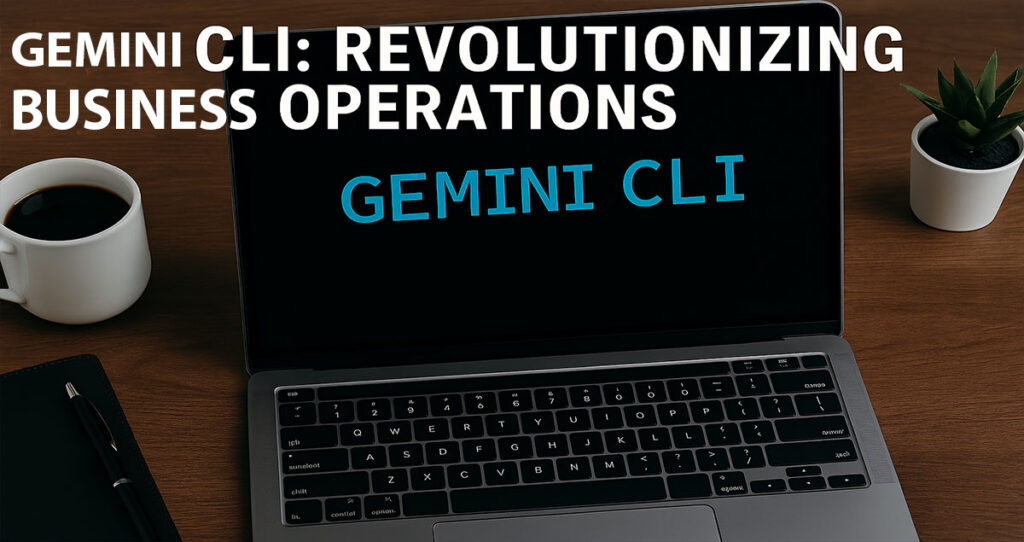Gemini CLI is a revolutionary, open-source command-line interface developed by Google to revolutionize business processes by bringing AI into terminal workflows. This effective tool helps developers and companies achieve a 3X improvement in efficiency, particularly in automated coding work, intelligent codebase analysis, natural language processing, and seamless interoperability with current development environments. The companies that use Gemini CLI report an overall increase in productivity, shorter development times, and more effective business operations across various business processes.
Introduction to Gemini CLI: Revolutionizing Business Operations
The business environment of today requires new forms of efficiency and productivity that have never been seen before. Organizations are always in search of new solutions that can help them address operations, cut costs, and grow. Google Gemini CLI then comes as one of the more revolutionary tools of any business, as it answers the following key business questions by taking the bridge of artificial intelligence to the command line interface.

Gemini CLI is a paradigm change in the way businesses do business using software development and operational tasks. This open-source AGI agent gives the developer instant access to the Google Gemini 2.5 Pro model, which has an impressive 1 million token context window. The free version of the tool allows 60 model requests a minute and 1,000 requests daily, which is why it is affordable to companies of any size.
Gemini CLI is not only important in the conventional development setting. Contemporary businesses would greatly benefit in terms of system administration, deployment activities, data analysis, and automated tasks by using command-line operations. Such a union of the AI characteristics in these workflows will lead to the elimination of the conflict between the human aspects and the procedural refinement within Gemini CLI.
The business leaders also know that the productivity of developers is related to the bottom-line performance. Since the development teams are in a position to accomplish tasks in a less consuming manner and at a very high level of accuracy, the entire organization experiences faster delivery of products, reduced costs of operations, and enhanced competitive advantages. Gemini CLI provides those benefits by making ordinary command-line communication smart and context-sensitive.
Such a structure of the tool lets it be easily added to the existing processes of development. As opposed to single-function AI assistant tools that require context switches, Gemini CLI is executed in the already comfortable terminal context where developers currently spend a lot of time during work. This organic fit avoids adoption obstacles and makes optimum instant productivity-benefit attainment.
Understanding Gemini CLI: Core Features and Capabilities
Gemini CLI is a powerful artificial intelligence tool perfect for operating in the command line. The tool is based on the use of the innovative models of Google used as the Gemini 2.5 Pro to provide it with the advanced capabilities of natural language processing within terminal sessions. The integration presents new possibilities for businesses to simplify their technical processes and boost developer efficiency as never before.
The fundamental design concept of Gemini CLI has been devised on the use of interpretable natural language interaction in command-line environments. App builders can communicate with the codebases, system setups, and worklog scripts in natural speech, as opposed to command code. This paradigm change lowers the learning curve for new members of the team, as well as speeding up the completion of tasks by already experienced developers.
Another very strong component of Gemini CLI is its large context window support. The 1 million token context window enables the AI to keep track of massive codebases, complicated project hierarchies, and long conversation threads. Such a wide memory allows making more correct recommendations, solving thematic problems, and providing more valuable answers to the questions of users.
The multimodal tool is not only associated with text processing, but it also supports image processing, document analysis, and media interpretation. Businesses may use these capabilities to create applications out of sketches, diagram technical plans, treat documentation, and create knowledge out of different media manifestations. Such broad functionality makes Gemini CLI useful in many business activities besides software development.
The connection between Google Search and Gemini CLI allows access to up-to-date information and best practices. Such a relationship allows AI to include the most recent industry standards, security guidelines, and technological changes in its responses. AI helps businesses stay in line with the fast-changing technology environment.
Open-sourcing of the Gemini CLI creates other benefits for deploying in enterprise applications. The tool can be customized to fit the business needs of an organization, integrated with its systems, and allow organizations to exercise control in handling sensitive information. The flexibility ensures business support in diverse environments and compliance and security needs.
Business Impact: How Gemini CLI Drives 3X Efficiency Improvements
Companies that have used Gemini CLI have always seen major increases in business productivity in various functional areas. The automation of repetitive actions, smart recommendations, and simplification of the complicated working process that the tool offers can be translated into a measurable increase in efficiency, directly influencing business performance.

Even development teams have rather direct challenges, resulting in the benefits of implementing the Gemini CLI. The natural language interface of the tool saves the time necessary to write, debug, and maintain the code. The developers shall be able to state desired functionality using plain English, and Gemini CLI will produce relevant rows of code, configuration files, and implementation strategies. This ability increases speed and minimizes testing errors.
With Gemini CLI, the process of code reviews will evolve to be smarter. The tool can present possible problems, outline advantageous solutions, and provide descriptions of the complicated sections of the code to the team members in automatic mode. Such automatic support can minimize the number of hours a senior engineer will have to spend on code review without reducing the quality thereof.
Automatic functions of Gemini CLI are useful in system administration procedures. Desirable complex systems of servers, deployment scripts, and maintenance procedures can be created and run by issuing natural language instructions. Such accessibility enables wider involvement of the team in tasks of operation and decreases overreliance on technical know-how.
Efficient project management is promoted with the help of the ability of Gemini CLI, which analyzes project structure, generates documentation, and provides insight into the progress of various projects. The tool will be able to automatically come up with status reports, have a look at possible bottlenecks, and recommend resource allocation enhancement. Such capabilities allow one to make more knowledgeable decisions and to be active in the management of projects.
Gemini CLI has quality assurance applications that use testing automation capabilities. Codebase analysis allows it to provide test cases, edge cases, and recommended complete testing approaches. The manual testing time is also limited by the automated support of testing with higher coverage and stability.
Business leaders have claimed savings in cost by shortening development time, fewer mistakes to correct, and better use of resources. The overall effect of smaller development cycles with improved code quality and a simplified operation allows generating a notable return on investment for companies using Gemini CLI.
Developer Productivity Enhancement Through AI Integration
Introducing artificial intelligence into the development processes is a creative shift in the way software organizations operate in their everyday routine. Gemini CLI is the extended arm that connects adventurous human creativity with AI potentials so that developers can concentrate on activities with high returns, where routine work and repetitive tasks can be accomplished automatically through Gemini CLI.
In modern development, it has become necessary to continuously switch contexts between tools, sources of documentation, and a knowledge base. Gemini CLI removes a lot of this friction, allowing the terminal to be used to navigate directly to the information, examples, and implementations that you need. Such smooth integration does not break the flow states of developers, and they save mental overhead.
The abilities to create code by snippets in Gemini CLI stretch further to the actual implementation of functions, classes, and application architecture. Developers only need to write a natural language description of complex requirements, and this will be given to them in the form of well-structured, well-written guidelines with a good number of comments with references to best practices and coding standards. This capability helps create features quickly and develop the best code.
Gemini CLI increases the effectiveness of debugging processes with its analytical abilities. The tool has the capability of analyzing errors, stack traces, and contexts of code with the aim of giving specific troubleshooting recommendations. This smart support minimizes the workload during the diagnosis of problems and allows the developers to gain knowledge from the experiences in debugging.
Another effect on productivity is the generation of documentation. Gemini CLI can scan code structure and produce detailed documentation, API references, and usage samples. This automatic generation of documentation will mean that projects will have proper documentation without the need for massive human resources in the development teams.
Gemini CLI educational capabilities help to make learning and skill enhancement go faster. It allows the new team members to ask questions regarding the unknown code, get an explanation of difficult concepts, and study desirable learning materials. Such AI-based mentoring complements conventional training and speeds up the onboarding procedures.
Since the tool helps to sustain the context during various interactions, the assistance can become more advanced with time. Based on the pattern, code style, and business needs of a project, Gemini CLI will improve the accuracy and usefulness of suggestions over time. This flexibility brings about an incremental productivity advantage for teams who use the tool.
Command Line Interface Revolution: Transforming Terminal Workflows
The command line interface has existed in the computing environment uninterrupted for decades and is the main means used to administer systems, develop programs, and perform other operations. Gemini CLI is a disruptive shift in changing such an essential interface by adding smart conversational abilities to terminal users, which reduces the experience of the application.

With conventional command-line stuff, the numerous syntax, parameters, and sequences of commands require the user to know them by heart. Such an aspect of the learning curve generates obstacles to new users and a sluggish performance by individuals who are familiar with a system or device in unorthodox circumstances. Gemini CLI will eliminate these difficulties by allowing a user to enter natural language (and convert it to a set of corresponding commands).
Gemini CLI communications are conversational, which makes the process of solving problems more natural. The users will be able to specify their objectives, constraints, and preferences using their natural language, and the AI will offer them the best ideas of how and what to implement. In such a way, it decreases the mental burden of command-line work and allows attention to more abstract purposes.
The complicated operations within the system can be made accessible through the guidance capabilities of Gemini CLI. It is possible to decompose a complex process into a series of steps with the help of the tool, justify the usage of a particular command, and offer alternative solutions depending on the needs. This learning factor assists the users in knowing how their systems operate, as opposed to the idea of blind implementation of certain commands.
Gemini CLI’s key feature, the ability to generate and optimize shell scripts, configuration files, and deployment processes, is of great contribution to automation scripting. In natural language, users can specify what they want in terms of automation workflows and obtain fully tested scripts that support those specifications. The skill generalizes the creation of automation and lowers the knowledge base necessary to carry out complicated working processes.
The ability to do error handling and troubleshooting is more convenient with the diagnostic features of Gemini CLI. In cases where the commands are not working or the systems are functioning in a way other than scripted, users can explain the symptoms and be provided with professionally actionable troubleshooting information. The smart support decreases downtimes and lets a user teach based on operating difficulties.
Real-time information/Google Search integration with command-line operations makes sure that the best practices and security recommendations are implemented as of now. Such a relationship to newer knowledge bases enables users not to engage with outdated practices but to develop current solutions to operational problems.
Artificial Intelligence Features: Advanced Capabilities for Business Growth
The artificial intelligence feature infused in the Gemini CLI goes way beyond mere command generation to intelligent, analytical, predictable, and creative capabilities that translate into quantifiable business expansion. The developed features help organizations cut across various areas of business using AI without disrupting workflow and interface design.
Gemini CLI has natural language processing that can execute highly complex text-related tasks: text analysis, content generation, and communication. These features can help business teams to generate reports, compose emails, create documents, and communicate with customers. The AI’s comprehension of context and tone will make the generated content at an appropriate level of professionalism.
Gemini CLI can be integrated with machine learning because this will enable the company to recognize patterns in codebases, business processes, and operational data. Such insights will help identify areas of optimization, learn about possible problems, and offer modifications to current processes. Data-driven decision-making with the help of AI analysis of complex business systems is beneficial to organizations.
The ability of multimodal processing enables the construction of the Gemini CLI to work with graphics, paper-based files, and multimedia. The ability is capable of supporting a diverse set of business applications, including reading technical diagrams and writing marketing materials. The adaptability in the consumption of many data formats through the same interface simplifies the work processes and reduces the level of interpretation in the use of tools.
The predictive analytics functions are used so that organizations can be able to foresee their future requirements and hitches. Gemini CLI can include historical data of the market, trends, and even a forecast of resource needs on how strategies are made and how resources are allocated. This prospective capacity facilitates dynamic management of businesses as well as a competitive edge.
Through integration capabilities, Gemini CLI can integrate with the existing business systems, databases, and APIs. This interoperability allows the usage of AI-based analysis of business data, intelligent collection of business reports, and control of business orchestration activities. Without disturbing traditional business processes, organizations will also be able to utilize AI capabilities.
The real-time adaptation makes sure that the responses of Gemini CLI are up-to-date with the present state of the business and industry norms. The linkage of the tool to the contemporary sources of information helps present up-to-date suggestions and prevent outdated practices. This currency is mandatory among companies existing in dynamic markets.
Open Source Advantages: Flexibility and Customization Benefits
The fact that Gemini CLI is an open-source tool gives a huge benefit to the companies that use it, but prefer to have control over their technological environment and use the AI solution. The strategy has its flexibility and customization of offerings, and cost-effectiveness that are unavailable through proprietary offerings.

The functionalities of customization enable entities to adapt the Gemini CLI to fit their particular business needs as well as connect to current systems. The development teams can expand the functionality of the tool, define custom commands, and apply organization-specific working procedures. Such flexibility makes AI-based capabilities adapt to the peculiarities of business activities as opposed to businesses expecting the tool limitations to conform to their needs.
In the open-source model, security and privacy benefits are gained because of the clarity and exposure to the community. The code can be audited by organizations, their data handling practices can be learned, and they can adopt more security mechanisms. Such a degree of control is pertinent to businesses that operate on very sensitive information or those having businesses in regulated sectors.
The reduced costs of open-source software include more than the licensing cost of the software and include lessened vendor lock-in and greater negotiating power. They can invest in their talent, help a community to grow, and have a lasting command over their AI infrastructure. This method offers improved total cost of ownership over proprietary options.
The worth of open-source adoption is increased through community endorsements and cooperation possibilities. Community-developed extensions may be used by organizations, and best practices shared, as well as working together to improve things to the benefit of all. This collaborative model speeds up the innovation and saves costs in developing individuals.
The flexibility of integration enables companies to use Gemini CLI in addition to other available open-source tools to develop extensive AI-based workflows. The strategy helps organizations to develop advanced solutions through the best-of-breed products as opposed to making trade-offs, which are the inherent trade-offs of monolithic proprietary systems.
The advantages of the adoption of open source in terms of long-term sustainability include less reliance on individual vendors, as well as having better control over the roadmaps of technology. AI tools allow organizations to keep operating and optimize such tools irrespective of the business decisions of vendors or the conditions on the market. This sustainability is essential to long-term technology investing and strategy planning.
Integration Strategies: Implementing Gemini CLI in Business Environments
The effective usage of Gemini CLI needs some planning, stakeholder involvement, and organized deployment steps that meet organizational objectives as well as current processes. The technical constraints, the training requirements, and the change management activities are the issues that businesses should consider to ensure that the integration of AI is beneficial.
The initial stages of assessment and planning must include a thorough review of existing work processes, defining points of automation, and evaluating possible productivity increases. Organizations have to be familiar with the current command line usage habits, who the power users are that can be change agents, and how you are going to be able to measure the success of the implementation.
Technical infrastructure involves reasonable network connectivity, proper security controls, and integration with other already existing development as well as operational tools. Policies on how to handle data, the limit of using APIs, and backup of operational processes must also be taken into account to avoid malfunctions of AI assistance.
The development approaches to training and adoption should aim at showing value and long-term competency development. Companies can undertake pilot projects with early adopters who show keen interest, develop insider literature and best practices, and support mentorship initiatives that allow members of teams to share best strategies for interacting with AI.
Change management factors may include extra attention to the fact that AI is seen as a threat to human abilities, a need to support the message about the augmentation, not replacement, philosophy, and the implementation should not be disruptive to productive workflows. Appropriate anticipations are facilitated by providing clear communication concerning both capabilities and potential limitations of AI.
The governance and the development of policies are responsible for ensuring that AI is used as per the standards of the organization, security measures, and even in compliance with regulations. The relevant organizations should set standards regarding the proper use of AI and how to handle data, and ensure quality assurance standards are maintained to allow taking advantage of AI features.
The measurement of monitoring and optimization performance gives the organizations the level of success in terms of implementations and views the areas of growth, streamlines its performance, and adjusts to the new strategies according to the actual use. Periodic monitoring of productivity indicators, user satisfaction, and business results will make sure that the introduction of AI brings the anticipated results.
Performance Metrics: Measuring Business Growth and Efficiency Gains
Measuring the business value of Gemini CLI implementation would be vital using inclusive metrics in gauging the steps to the productivity gains, cost reductions, and quality adjustments of the implementation in different functions of an organization. The measurements are evidence of return on investment and indicate a way to optimize.

The measures of such productivity include the speed of generated code, the shortened time spent debugging the code, and faster speed in delivery of features. To measure efficiency gains by developers, organizations can monitor the number of lines of code written, bugs fixed, and time to finalize the projects. Such metrics give conclusive proof of the role of AI in the fundamental processes of development.
Quality metrics include reduced time to review code, bug-catching rates, and after-deployment quality of issues. Better quality code with the aid of AI can lead to fewer production issues, lower maintenance costs, and more satisfied customers. These quality gains directly relate to cost savings and competitive gains.
Such measures of operational efficiency are the completion time of system administration tasks, the rate at which deployments are made, and the overhead of the infrastructure managed. The operational benefits may be measured in terms of time and cost that can be saved by the organization as a result of the automation of routine processes, reduced manual interventions, and enhanced system reliability.
Learning and development measures will include measuring the time of integrating new members of the team onboard, the speed of new skills acquisition, and the ability of knowledge transfer. The role of AI in the learning process should also speed up the process of competency building and decrease the time of incorporation into the working process by new employees.
Direct savings on shortened development time, indirect returns on enhanced quality, and strategic returns on shortened time-to-market should all be subject to cost analysis. When organizations assess success in AI implementation, the aspects that should be taken into account are the immediate effect on costs, as well as long-term competitive positioning advantages.
The level of usage and the degree of user satisfaction are qualitative measures supplementing the quantitative measures. The frequent surveys, utilization statistics, and feedback gatherings assist an organization in comprehending how AI tools are utilized and where some flaws or development options can be discovered.
Industry Applications: Sector-Specific Benefits and Use Cases
The implementation of Gemini CLI benefits different industries according to their respective operational needs and regulations, and their own business goals and aims. By having an idea of such industry-specific applications, organizations can find pertinent use cases and ways of optimizing them.
The greatest advantage of using Gemini CLI is perceived in software development companies. With the help of AI, these organizations may achieve a faster development cycle, better code, and improved documentation. The capacity of the tool to interpret extensive codebases and suggest contextual support is the ideal match with software development processes.
The financial services organizations are advantaged by the capability of Gemini CLI to automate compliance reporting, create audit documents, and facilitate regulatory submissions. The analysis tool can provide patterns in financial data, identify anomalies, and make suggestions that make trading and risk management decisions.
Gemini CLI is a technology that can be used by healthcare technology companies when developing medical software and conducting clinical data analysis, and healthcare system integration. The aptitude of the tool in approaching the bulkier documentation and creating compliant code assists in the requirements of strict healthcare software development.
Gemini CLI is used in manufacturing enterprises where it can be applied in the automation of industries, strengthening of supply chains, and quality control systems. The productivity of the tool to scan operational data and produce control scripts can reinforce manufacturing effectiveness and predictive maintenance schemes.
Gemini CLI is useful to e-commerce platforms because it can help to optimize the performance of the website, understand customer behavior, and automate marketing campaigns. The product can automatically meet the needs of customer service and personalized shopping through its natural language processing capabilities.
Gemini CLI can be used in educational institutions as a tool of administrative automation, curriculum development, and student information systems. The image generator capabilities of the tool in generating educational content and analyzing the learning patterns promote efficient educational outcomes and operational efficiencies.
Future Prospects: Evolving Capabilities and Business Opportunities
The course of the development of the Gemini CLI indicates the extensive expansion of functions and business uses within a few years. Knowledge of such prospects aids organizations in strategizing on AI deployments and determining new opportunities for a competitive edge.

The most likely extension of high-level automation is the automation of business processes. Subsequent releases are likely to be combined with enterprise resource planning systems, customer relationship management systems, and business intelligence programs to deliver end-to-end AI-driven business automation.
Improved features of collaboration might allow multi-user AI sessions, shared context between team members, and collaborative ability to solve problems. Such advances would foster remote work teams, as well as allow higher-order processes of AI-assisted project management and decision-making.
Industry-specific adaptations can potentially be adopted to cover specific mandatory practices in the industries that are regulated, niche professional fields of technology, and newer fields of technology. These custom functions would be more compatible with the industry-related applications and regulations.
Predictions might further be developed to suggest higher levels of forecasting, risk identification, and seeking opportunities. Integration of advanced analytics might allow AI to process business trends and make market forecasts and suggestions on suitable sets of change depending on thorough data-based analysis.
The growth of the ecosystem of integration is also likely to be extended towards connectivity to other third-party tools, cloud, and business applications. This would increase connectivity and allow workflows powered by AI to be more holistic, and allow organizations to use AI on their complete technology stack.
The ability to push the boundaries ever wider with fewer computational resources will and must be enabled by optimization of performance and efficiency. The resulting progress will reduce the size of the organization to enable the use of more advanced features of AI and allow the deployment of more advanced applications on off-the-shelf computing platforms.
Security and Privacy Considerations for Enterprise Adoption
The use of enterprise antivirus with Gemini CLI should be considered with caution, with security implications, data privacy policy, and compliance criteria. Organizations should put proper guards in place to best utilize the gains of productivity brought by the use of AI.
The security of sensitive data needs to be adequately handled through policies of data handling in the process of interactions with AI. The companies should set up clear policies or guidance on what kind of information can be disclosed to AI and set up technical safeguards against the disclosure of unauthorized data.
The access policies must restrict the AI functions to those users to whom it would be beneficial, but must guarantee that the boundaries of security are guarded. Role-based access controls, authentication requirements, and audit logging allow organizations to be secure and be able to use the AI productively.
Among network security measures, one should name the need to secure API communications, install relevant firewalls, and monitor the network traffic related to AI. Companies should make sure that their AI interactions do not generate new attack surfaces or otherwise weaken security checkpoints.
Depending on jurisdiction and industry, compliance may be different, and thus, organizations need to know how the use of AI influences their need to comply. Government structures or financial and healthcare institutions are considered to have even higher demand, which should be considered at the time of AI implementation.
The privacy protection measures must deal with user privacy, customer data privacy, and protection of intellectual property. Technical and procedural controls in organizations must stop unauthorized access to sensitive organizational information and facilitate the productive use of AI.
The necessity to take into consideration AI-related security incidents, such as the possible data breaches, unauthorized access attempts, and compromises, should be considered when establishing the framework, unless there is any. AI-related security incident detection, response, and recovery procedures are clear, which contributes to an effective organizational security level.
Cost-Benefit Analysis: ROI of Gemini CLI Implementation
The most interesting question that a cost-benefit analysis of Gemini CLI implementation may consist of is a direct comparison between cost, indirect benefit, and long-range strategic benefits. When organizations evaluate the impact of AI, there are several elements that need consideration with regard to the financial implications of adoption.
The costs of implementation entail the original installation costs, training needs, and changes to the infrastructure. During the adoption, organizations will have to allocate funds to have users trained, ensure system integration, and possibly improve productivity. Such direct investments ought to be balanced against anticipated long-term gains.

Operational savings are introduced by saving time in development and having fewer mistakes, and enhanced efficiency in various business functions. Companies can also estimate such savings, calculating increases in productivity, reduction of errors, and optimization of resources.
Long-term competitive benefits due to time-to-market acceleration, better quality of the products, and customer satisfaction may surpass direct benefits associated with cost reductions. These strategic advantages may be hard to measure, yet they are usually the highest value of AI implementation.
The advantages of performing risk mitigation steps include a decrease in the number of project delays, an improvement in the level of quality control, and an increase in compliance possibilities. These help to reduce risks and thus cost avoidance and increased business predictability, which helps in better financial planning and the use of resources.
Scalability benefits allow an organization to do more work without comparing the amounts in employee costs. The efficiency gains enabled by AI will allow a business to grow and sustain its position in the market without escalating prices or breaking the bank.
The factors that contribute more employee satisfaction, more learning opportunities, and more immediate innovation capability are all a part of long-term value creation. These advantages contribute to organizational stability and competitive aspects in the highly dynamic markets.
Training and Adoption Best Practices
Effective implementation of Gemini CLI needs intensive training covering technical, workflow mixture, and cultural change implementation. To make the most of the implementation of AI, organizations will have to invest in user education and support systems.
The early training sessions are aimed at learning the basic methods of interaction with AI, command-line basics, and certain use cases of interest to the particular user. Practical workshops, practical tutorials, and practical examples make the development of competency and confidence levels with AI tools easier.
The continual training programs make sure that the user keeps in touch with the growing capabilities of AI and gets to learn new ways of achieving high productivity. Continuous learning and improvement are achieved through regular training updates, sharing of best practices, and peer mentoring programs.
Documentation and reference materials will enable the user to have guidance, examples, and troubleshooting content instantly. Thorough documentation lowers support overhead, and users can perform self-help in resolving problems.
AI champions will be developed internally through community-building activities that will allow AI champions to share experiences and offer each other peer support, as well as further adoption within the organization. Such communities speed up the learning process and contribute to the fact that the use of AI becomes the usual aspect of doing business.
Feedback and success measurement of adoption allow organizations to know the progression, the gap in training, and the adjustment of the support strategy. The surveys should be regularly conducted along with the usage statistics, and the performance indicators give ways to information on the training effectiveness and customer satisfaction.
The change management strategies deal with the concerns that AI will replace humans and inform the users that AI augments and does not negate their capabilities. It is possible to explain the benefits and shortcomings of AI to help establish pertinent expectations and streamline adoption efforts.
Conclusion: Embracing the Future of AI-Powered Business Growth
Gemini CLI is an opportunity that is revolutionary to enables businesses to use artificial intelligence to make accurate gains in productivity and competitiveness. The set of such enhanced features of the AI technology, combined with open-source flexibility and the ease of integration into the current operations, makes the tool presents an unprecedented possibility of improving the operations and expanding business.
Companies that adopt Gemini CLI during its initial growth stage prepare themselves to gain access to the abiding stream of new capabilities and develop in-house competence working with AI-empowered tools. The synergetic effect of increasing productivity and quality and enhancing rapid innovation provides sustainable competitive advantages, which go much beyond immediate savings.
The 3X efficiency gains that have been achieved by the early adopters prove that business transformation with AI integration has much potential. The result of these productivity gains is that organizations will be able to achieve more with the resources available, they can undertake more projects, and they can act faster upon opportunities in the market.
Gemini CLI needs equally thorough implementation planning, training, and continuing optimization to succeed. Companies that make the necessary efforts to adopt their new AI technologies and keep user success in mind will reap the most benefits out of the productivity gains brought about by AI.
The capacity in the sphere of business operations of the future comes to rely more and more on the successful adaptation of AI, which augments human functions rather than replaces them. Gemini CLI is a convenient place to start this transformation, where organizations have control over their technology infrastructure and business processes.
With the functionality of AI expanding, the earlier an organization resorts to competency on tools such as Gemini CLI, the more likely it will be able to utilize any future innovations and remain ample within an optimal position in a certain market. The modern-day investment in implementing AI allows enterprises to establish a foundation upon which they are to conduct their further evolution and success in the existing competitive global economy.
Frequently Asked Questions (FAQ)
What is the Gemini CLI? What is it, and how does it work?
Gemini CLI is an open-source command-line interface developed by Google, which inserts artificial intelligence into the core business of terminals. It is compatible by connecting with the Google Unleashed Gemini 2.5 Pro model, which is an artificial intelligence-enabled programming, system management, and other operations enhancement for developers and businesses. The tool can decode natural language and convert it into suitable commands, code fragments, or solutions, simplifying and accelerating technical tasks and procedures.
How does Gemini CLI achieve 3X efficiency improvements?
Multiple productivity improvements, such as automated code generation, intelligent debugging aids, simplified documentation creation, and natural language command processing, give 3X increases in efficiency. They can write a task in the form of plain English instead of remembering hard-to-use syntax, get immediate answers to coding queries, and automate repetitive activities. All these are great conveniences because they not only save on time wasted when carrying out the task manually but are also much more accurate and produce better results.
Is Gemini CLI suitable for small businesses or only large enterprises?
Gemini CLI is suited to work in any organization, regardless of its size. It is affordable to small teams, with a free plan providing 60 requests per minute and 1,000 requests every day. Its open-source nature also saves developers the licensing cost, and because it can be used to speed up the development and eliminate the number of errors, it is immediately cost-effective to the developer, no matter the size of the company. The efficiency of their systems also makes small businesses adopt technologies and earn ROI more often and quicker.
What are the security implications of using Gemini CLI in enterprise environments?
Enterprise protection in terms of consideration comprises data handling policies, access controls, network security, and compliance. Organizations ought to define procedures regarding what information can be used by AI systems, use role-based cascade parameters, and have valuable API communications. Its open-source property allows its security to audit and side write its potential implementation to achieve the required security requirements. Several businesses develop closed systems or on-premises deployments to regulate data.
How long does it take to implement Gemini CLI in a business environment?
The time to implement comes with differences depending on the size and complexity of the organization. Initial installation may be achieved in a few hours, although overall, proceeding requires 2-4 weeks to educate users, integrate workflows and/or architectures, and create micromanagement policies. Organizations are advised to prepare a preliminary installation, user education, a pilot with first users, and its gradual introduction to the rest of the staff. The ability to change and get users to adopt rather than the complexity of the technical implementation is a better measurement of success.






